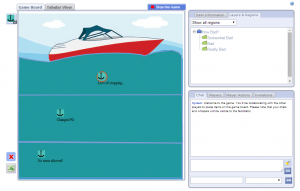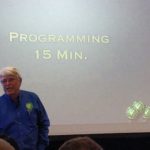Enterprise Retrospectives – talk by Luke Hohmann

Luke Hohmann
Yesterday’s tube strike stopped many of London’s Agile Scrum community from hearing the talk by the popular Silicon Valley author Luke Hohmann.
With an easy charm, infectious laughter and a raft of terms someone described as “Californiguff”, Luke wasted no time on “talking heads” and got everyone into classic workshop groups to do a retrospective of retrospectives.Luke’s presentation style resonated with me as he announced above the chatter “yeah, this is how I run workshops – they’re noisy!”
Keeping his audience actively engaged in discussing, comparing, reviewing and finally parading a graph for inspection, Luke proved his impeccable facilitation credentials. Given that the group had very mixed involvement with agile, ranging from a coach with his scrum master, to project managers, novices and experts, it was curious to see that the outcomes of the retrospectives (of retrospectives) were in alignment.
The results showed that retrospectives are valuable at first and the team improves. Then the effectiveness of the retrospective decays over time, until people eventually start wishing they didn’t have to do it any longer. According to Luke this is universal.
The final activity is set was in the form of a challenge to arrange for several teams to do a collaborative retrospective. For anyone who “needed figures to work with” he invented seven teams separated by five time zones and at least two spoken languages. A couple of teams came up with “scrum of scrum” style retrospectives, with rotating membership. This drew an “Ah, the Blessed One shall represent us. When is it my turn to be the Blessed One?” comment from Luke, before the bigger question was raised. Why would you do this at all?
“You must read The Mythical Man Month. Really, make room for it on your bookshop by throwing away one of my books if you have to. Hell, throw away two of my books if you have to, but get this book”. Luke set off on the sidebar, which he drew in the air.
“Interesting things can’t be built by small teams, at least for the clients I work with.” Luke cited Rackspace as an example that had grown by acquisition and now have every type of platform, language, methodology and toolset you can imagine. “These teams have to collaborate on large-scale projects, even though the agile terrorists don’t like to admit that they have projects, and they need enterprise retrospectives if they are to improve their processes and scale effectively,”
His comment “you can only scale through architecture” got nods of agreement from the architects in the room and marked the boundary of another sidebar. The reason I mention these sidebars is this was the precise moment Luke suggested “we break for zaa”. He answered the puzzled looks by saying “zaa” was Silicon Valley-speak for pizza. it was a real cliffhanger – two sidebar detours away from revealing the solution to the challenge of organising an enterprise retrospective. Then someone asked for “a teaser”. Something to ponder over pizza, or something tangible for the one member who had to leave at that moment to catch a lift home.
The teaser was a good summary without giving away anything significant. “Honour the teams, they have a shared transactional memory system” was about validating the progress the team had already made in its own development, using retrospectives. But don’t make changes to your teams now, they had learned to compensate for each other’s weaknesses and truly work as a unit. But they had reached the stage where they could not optimise themselves any further. Team performance was done, and enterprise performance was now needed. Hence the need for an enterprise retrospective. Luke had introduced himself as “a total geek” and proved this now by adding “see, I always take care of my stack”. Sure enough, he’d addressed the original question via two really valuable sidebars, and revealed the purpose of his initial activities. So now it was “zaa” time with no more teasers.
Where the first part had been thought-provoking, random, relaxed, revealing and insightful, part two had another feeling, as Luke sped through PowerPoint slides, only coming to rest on a drawing of a speedboat. The boat was the solution to the challenge of enterprise retrospectives and was part of the online toolset that Luke had developed.

Each team gets to play a game with the boat as a retrospective activity every six months. Members place anchors to indicate events that slowed-down the progress of their boat (project). Apparently spaceships and racing cars are popular replacements for the speedboat and there’s also a sailing boat option for the environmentally-minded. By focusing attention on anchors and propellers, rather than audio and video, the game levels the playing field between the dominators and the wallflowers, as well as component and feature teams, or even sales and support teams.
Once everyone has described their anchors, the results can be analysed, prioritised, and improvement items selected.
Speedboat is just one of the games that Luke’s Innovation Games platform provides. Anyone who is serious about scaling Agile Scrum should give it their attention, and anyone who missed Luke’s talk should make certain they catch him next time he is in town.



